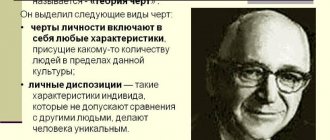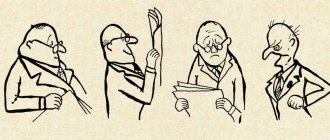Good afternoon or evening, dear readers. Each of us has an individual character, and of course, there are no people of the same type in the world. Scientists have long proven that even twins differ in character type, despite their similarity and upbringing using the same method.
Do you think that you have a good understanding of people and see right through them? Actually this is not true. What kind of character is a person? This can be judged only after a complete study of all types and highlighting the main parameters.
Definition and general characteristics of the concept
Character is a set of stable traits that determine a person’s behavior, his lifestyle, habits, and reactions to various situations. Character is not an innate component of the psyche, but is formed throughout life. The basis for the formation of character is biological characteristics: gender, type of temperament, set of genes. Refracted through the prism of education and individual development, they form a unique psychological picture.
The word “character” translated from Greek means “imprint, seal.” This is what distinguishes a person from other people, makes him unique and inimitable. It is impossible to meet two people with absolutely identical characters.
Character plays a decisive role in our lives. Everything we do, what we think, what emotions we experience is determined by our character. This is a kind of set of patterns fixed in the psyche that are designed to simplify our existence. Imagine: faced with the same situation every time, we would have to re-evaluate it, build a behavior strategy, and analyze the consequences. Character allows you to optimize this process.
Knowing a person's character well, you can almost accurately predict his behavior.
The meaning of the word Character according to the dictionary of medical terms:
character (Greek charakter distinctive feature, feature) - a set of basic distinctive properties of a person, manifested in the peculiarities of his behavior and attitude to the surrounding reality. Synonyms for the word character: Character, disposition, temperament, nature, temperament, appearance, type, style, form , cut, appearance, guise. He has such a nature. The girl I fell in love with was of a silent nature. Temperament: violent, meek, cool, quiet. Wed. Quality. See view, quality || in character, maintain character, lose sharp character
Character traits
Those traits that most often appear in similar life situations are character traits.
For example, a person usually behaves friendly and affable with others, but one day he breaks down and becomes rude. In this case, rudeness is not a character trait. This is a consequence of a situational factor. Most likely, the person was tired or upset. But friendliness can be fully attributed to the stable traits of his character.
All traits are usually divided into three groups depending on their focus. Each group also has positive and negative traits.
- Attitude towards yourself
This group of traits reflects a person’s attitude towards his own self. These include self-respect, pride, modesty, self-criticism, vanity, arrogance, pride, etc. The combination of these characteristics determines how a person positions himself in life, what place he places himself in relation to other people, how he evaluates his successes and failures, and what his goals are. chooses.
- Attitude towards other people
These are character traits associated with social interaction. Positive ones include responsiveness, friendliness, sociability, altruism, sensitivity, respect; negative ones include snobbery, contempt, isolation, callousness, and cynicism. The effectiveness of communication directly depends on these traits.
- Attitude to activity
These include hard work, responsibility, activity, diligence, creativity, accuracy, and perfectionism. And also laziness, passivity, irresponsibility. These traits are manifested in professional activity, in a person’s attitude to affairs and responsibilities.
The combination of traits from these three groups forms the character structure and a unique psychological portrait of a person.
Similar words
Charactertron Characteristic Characteristic Characteristic Characteristic Characteristic Characterology Characteropathy Characteristic Characterizing Characterized Characterized Characteristic Characteristic Characteristic Characteristic Actor Characteristic Dance Characterized Characterized Characterized Characterized Characteristic Characteristic Characteristic Characteristic Characterized Pathological character Characteristic curve Characteristic spectra Characteristic equation
Character Formation
Scientists have for many years considered character to be an innate component of the psyche. This hypothesis was subsequently revised. Today there is no longer any doubt that character is formed throughout life. This idea was first expressed by the English philosopher John Locke.
Character begins to be formed immediately after birth. At this stage, a basic attitude towards trust or distrust in the world is formed. It is very important to surround the baby with love and care, to satisfy all his vital needs in a timely manner, and to take an active part in development.
The child grows up and begins to actively explore the world. Parents play the role of mediators and guides in this process. Their authority for the child is enormous. They have the strongest influence on the formation of his character. A child acquires some traits as a result of imitation, and some are formed as a result of targeted training.
After three years, the child’s social circle expands, peers and new adults appear in it. Character traits associated with social interaction begin to form: sociability, kindness, generosity, responsiveness.
When a child goes to school, adults’ assessments of his actions begin to play an important role in his life. An idea of what is good and what is bad is formed. Active socialization occurs, and the role of parents in the further formation of character begins to decline. The child manifests himself in vigorous activity, and the traits associated with it begin to develop: hard work, responsibility, initiative, punctuality.
Adolescents are actively developing moral, ethical and volitional qualities. By adulthood, the character is, as a rule, already fully formed. In the future, only adjustments to its individual features occur.
Thus, we can identify the main factors influencing the formation of character:
- parental education;
- cultural values proclaimed in society;
- personal example of people significant to a person;
- public opinion;
- self-development.
The meaning of the word Character according to Dahl's dictionary:
Character of M. French. German a person’s disposition, moral properties, qualities, properties of the soul and heart. The character is good-natured, meek. He has a cool character. The nature of the time, spirit, distinctive properties. | The nature of architecture, painting, peculiarity, originality, main difference, school, damage. A characterful person, firm, persistent, with convictions. stubborn, persistent. - a dance, folk and generally expressive, with lively body movements. -ristics of something, a brief and correct description of the main properties, characteristics. -tic, -tic, related to this. - to describe something, to describe, to depict clearly, sharply the main features, properties, signs of something. -sya, they suffer. and return -vanier cf. - call valid according to verb.
How is character different from temperament?
These two concepts are often confused or identified with each other. Let's be clear. Character and temperament are not the same thing, although they are closely related.
The first and most significant difference is that temperament is an innate indicator, and character is acquired.
The type of temperament is determined by the characteristics of the nervous system of each individual. Based on the combination of such general characteristics as strength, balance, and mobility of the nervous system, 4 types of temperament are distinguished:
- Sanguines. Strong, balanced, mobile nervous system. They are characterized by sociability, optimism, energy, and activity.
- Cholerics. Strong, unbalanced, mobile nervous system. They are characterized by high emotionality, quick temper, determination, and sociability.
- Phlegmatic people. Strong, balanced, inert nervous system. Phlegmatic people are slow, calm, efficient, and withdrawn.
- Melancholic people. Weak, unbalanced, inert nervous system. Melancholic people are vulnerable, sensitive, anxious and withdrawn.
Temperament is the basis on which character is formed. However, one should not assume that temperament completely determines him. The human psyche is very plastic - it can adapt to any conditions. People with different temperaments may have similar character traits, they will just manifest themselves differently.
For example, let’s take the quality of determination. Choleric people go straight to their goal. Any obstacles ignite sporting anger and passion in them. Sanguine people act methodically and confidently, do not give in to emotions and weigh every step. Phlegmatic people move towards the goal according to the principle “the slower you go, the further you will go.” Melancholic people have to constantly push themselves emotionally in order to maintain a high level of motivation.
There are traits that are more likely to develop in certain temperament types than others. But this does not mean that a person cannot go against the flow and shape them consciously through volitional efforts. Character can mask some of the innate manifestations, enhance others and inhibit others due to the formation and strengthening of new reflex connections.
Therefore, you need to constantly work on your character: get rid of bad traits and cultivate good ones. This is an interesting and creative process. Treat it like a game.
Kretschmer classification
Scientists, psychologists and other scientists have long distributed criteria for different personalities. It’s very simple, if a person doubts who he is, he can study the typology according to Kretschmer.
This outstanding person created a table for determining a person’s character by his physique. Here we can distinguish 3 main typologies:
- Picnics. People are short, overweight, have short necks and small heads. They belong to the cyclothymic character type. Sociable, good-natured, but very emotional personalities.
They get along well in society, are not prone to serious scandals, and can get along with even the most unpredictable creatures. Such figures are prone to certain mental illnesses, such as manic-depressive psychosis.
- Asthenics. Men and women of tall, thin build. Long arms and legs immediately reveal such personalities. The face is elongated and thin, with many facial wrinkles. The character type of such individuals is schizothymic.
Figures of this type rarely smile, are not prone to constant fun, and take life very seriously. Stubbornness and isolation allow them to achieve success in their careers and personal lives. They may suffer, like picnics, from mental illness. Most often, patients classified as asthenics develop schizophrenia.
- Athletics. The name speaks for itself. Personalities of this type are tall, broad-shouldered, with prominent muscles. The category of such people is ixothymic. Athletics are stubborn, reserved and resilient people.
They clearly follow the goal and achieve it by any means. A calm, balanced life helps them deal with hardships, but they are very afraid of change, as they do not adapt well to the new environment and the surrounding society.
Many years of research by scientists have proven that people of the same race have similar character traits. The famous scientist Anders Retzius studied the Nordic character for a long time.
It was he who introduced the term “Nordic” for a more clear separation of all types and categories. He took the Germanic races as a basis for his research, and made a real breakthrough in his endeavors.
During the work, it became clear that individuals of German origin are tall, not overweight, have blond hair, and blue eyes. They are distinguished by endurance, resistance to external irritants, very cool-blooded and calm even in emergency situations.
What is character accentuation
Accentuation is an extreme degree of expression of some specific character traits. A person with accentuation of character is mentally healthy, but on the very border of the norm.
Under unfavorable conditions, accentuation can develop into a mental disorder, leading to alcoholism, drug addiction, deviant behavior and suicide.
Accentuations are most common among teenagers. According to statistics, 95% of boys and girls aged 14–17 years have sharpened, hypertrophied character traits. With age, this figure decreases to 60%.
Accentuations cause personality disharmony, complicate socialization and general adaptation, and reduce productivity in all areas of life. The formation of accentuation is influenced by both hereditary factors and upbringing.
Character in the Encyclopedic Dictionary:
Character - artistic - is the image of a person in a literary work, outlined with a certain completeness and individual certainty, through which both a historically conditioned type of behavior and the moral and aesthetic concept of human existence inherent in the author are revealed. The principles and techniques for recreating character differ depending on tragic, satirical and other ways of depicting life, on the literary type of work and genre. they largely determine the face of a literary movement.
(from the Greek charakter - a distinctive feature - a sign),..1) a peculiar feature of a person, thing, phenomenon (for example, the character of a locality) ... 2) In psychology - the individual makeup of a person’s personality, manifested in the characteristics of behavior and attitudes (attitudes) around reality.
Character types
In psychology, there are several classifications of character types. Let's look at and give a brief description of the main ones.
Jung's classification
Perhaps the most common classification in psychology that everyone has heard of. Swiss scientist Carl Gustav Jung, a student and follower of Sigmund Freud, classified people according to the direction of their vital energy. He identified two types:
- Extroverts. These are people whose main attention and energy are directed outward. They are sociable, active, cheerful. They love to be in the company of people; they are uncomfortable alone. Extroverts are not inclined to worry for a long time about failures and problems and indulge in painful reflection.
- Introverts. Their energy is directed inward. Recent studies have concluded that introverts have a more sensitive nervous system than extroverts. Therefore, they take everything to heart and love to delve into themselves. Introverts prefer to spend time alone with themselves; communication takes a lot of their energy.
Subsequently, the American psychologist Edmund Conklin added another type to the classification, identifying ambiverts. These people combine traits of both introvert and extrovert. They enjoy spending time in the company of people, but sometimes they need to be alone. This duality makes them incredibly flexible and allows them to adapt to any conditions.
Kretschmer classification
The German scientist Ernst Kretschmer associated character traits with a person’s physique. He divided people into three types:
- Picnics. These are people of short or average height, stocky, and prone to being overweight. They have a small head, short neck, and small facial features. They are characterized by such qualities as sociability, optimism, emotionality, and activity. Picnics have a good sense of humor, they easily find a common language with everyone, so they often become the life of the party.
- Asthenics. People of this species are thin, with underdeveloped muscles and long limbs. By nature they are stubborn, reserved, sensitive and serious.
- Athletics. Tall, broad-shouldered, muscular. They are characterized by restraint, prudence, calmness and authority. Athletics do not adapt well to new conditions, so they value stability and constancy.
Lowen classification
American psychologist Alexander Lowen identified character types based on the protective mechanisms of the psyche that prevail in an individual. There were five of them in total:
- Oral. This type of people is extremely dependent on other people's opinions. Its representatives are terrified of criticism, condemnation, and rejection by people. They need constant love and moral support, but they themselves are quite passive.
- Masochistic. People with this type of character are suspicious, anxious, and pessimistic. They treat others with caution, sometimes even with hatred, but they try not to show it. They experience masochistic pleasure from suffering, love to complain about their misfortunes and ruin people's mood. They feel good when others feel bad, and vice versa.
- Hysterical. This is about the fact that “the whole world is a theater, and the people in it are actors.” This is exactly what the world looks like in the minds of hysterical people. They are distinguished by violent manifestations of emotions, theatrical behavior, and exaggerated reactions to current events. They love drama in all its forms and cannot stand calm and stability, so they often get involved in various dubious stories.
- Narcissistic. It is more pronounced in men. Representatives of this type are charismatic, assertive, purposeful, and energetic. They set ambitious goals and confidently implement them. Many of them become leaders because of the love of power and the desire to dominate. The flip side of their character is aggressiveness and authoritarianism.
- Schizoid. People of this type live in their own fictional world. They are closed, unsociable and anxious. Schizoids have problems establishing close relationships, so they can remain alone all their lives.
These types are rarely found in their pure form. Most often, a person has a mixture of 2-3 types.
Leonard classification
The German psychologist Karl Leonhard studied character accentuations. In his book “Accented Personalities,” he identified 10 main types:
- Hyperthymic. Characterized by sociability, activity, optimism, and energy. Such people are always in search of new experiences and bright emotions and cannot stand boredom. They are often too frivolous.
- Disthymic. Representatives of this type are pessimistic, anxious, withdrawn and vulnerable. They have few friends and prefer loneliness to noisy companies. They have difficulty making decisions, hesitate for a long time and torment themselves with doubts.
- Excitable. Hot-tempered, conflictual and aggressive people. They get along very poorly with others and often become tyrants at home.
- Stuck. These are stubborn, touchy, suspicious people. They love to teach and instruct people without asking them, for which they are often considered boring. They are sensitive to injustice, sensitive to criticism, and vindictive.
- Demonstrative. Representatives of this type love attention in all its forms. They are self-confident, boastful, emotional, shocking. They love to weave intrigues, manipulate people and provoke them to emotions. Among their positive traits, it is worth highlighting artistry, flexibility and innovative thinking.
- Anxious. Timid, quiet, insecure people. They are self-critical, pessimistic, sensitive and vulnerable. They behave kindly with people, avoid any conflicts, but deep down they are wary of everyone. They are also distinguished by a lack of willpower, lack of initiative, and indecision.
- Emotive. These people are emotional, responsive, and kind-hearted. We are always happy to help those in trouble. They take everything to heart, but do not demonstrate it, but accumulate experiences inside.
- Pedantic. Such people are distinguished by neatness, a passion for order, perfectionism, and an obsession with detail. At the same time, they are serious, conscientious and reliable; loved ones can rely on them. They do not have leadership qualities, so they prefer to be led.
- Exalted. Extremely impressionable, emotional and sensitive people. They react violently to everything that happens: pleasant events cause them delight, and unpleasant ones drive them into melancholy and despair.
- Affectively labile. People with this type of accentuation are emotionally unstable and subject to causeless mood swings. Therefore, some people consider them sociable and cheerful, while others think that they are withdrawn and gloomy.
Take a look at our selection of tests to determine your personality type.
More than 100 cool lessons, tests and exercises for brain development
Start developing
Lichko classification
Soviet psychiatrist Andrei Evgenievich Lichko also studied character accentuations. There are 11 types in his classification:
- Hyperthymic. Sociable, positive, good-natured person. Cannot stand stability, always looking for adventure and strong emotions. Often puts himself at risk to get a dose of adrenaline. He is fickle in his passions and often leaves things he has started unfinished.
- Cycloid. It is characterized by an unstable energy state. During periods of recovery, he is sociable, cheerful, active, and during periods of decline, he plunges into depression. Each phase lasts approximately 2–3 weeks.
- Labile. Characterized by frequent mood swings and unpredictable reactions. The same event, depending on his mood, may seem either interesting and exciting, or frightening and stressful. Any little thing can cause a change in mood: a disapproving glance from a passerby, a beautiful landscape from the window, a random song from the past.
- Asthenoneurotic. Suspicious, capricious, easily tired type. Prone to hypochondria, i.e. obsessive worry about one's health. He is drawn to people, but quickly gets tired of them and returns to loneliness.
- Sensitive. Sensitive, vulnerable, impressionable person. He is extremely demanding of himself, because of this he suffers from low self-esteem and worries about his shortcomings. With new people he behaves warily and withdrawn, but in the company of acquaintances he relaxes. Anxious and fearful. Often gives in to difficulties because of fear.
- Psychasthenic. Likes to think, reason, rationalize. Has difficulty making decisions and taking responsibility. Characterized by high fatigue, anxiety, and suspiciousness.
- Schizoid. Closed, unsociable, anxious type. He lives in his own world of illusions, where he does not let anyone in. Has difficulty establishing emotional contacts and suffers from this himself. He dreams of finding a close friend who will understand and support him.
- Epileptoid. Irritable, explosive, prone to passions. Attacks of anger and irritation can last for several days in a row. All this time he is looking for an object on which he can throw out his negative emotions. Very jealous in relationships.
- Hysterical. He is distinguished by egocentrism, constant thirst for attention, shockingness, and demonstrativeness. For the sake of a portion of attention, I am ready to do anything. He may even feign suicide attempts.
- Unstable. Inclined to idleness, idleness, and various types of entertainment. He is not ambitious, has no career or life goals, lives one day at a time. He is cowardly and lacking initiative, needs care and protection. Incapable of experiencing deep, sincere feelings, he is indifferent to the needs of loved ones.
- Conformal. Constantly adapts to the environment, does not have his own point of view, prefers to rely on the opinion of authorities in everything. He has no leadership qualities at all, is cowardly and lacks initiative.
Typology according to Jung
For centuries, humanity has been studying each other, each scientist tries to present his point of view and spread it to the masses. A psychiatrist from Switzerland did not stand aside and began to study humanity based on its internal and external awareness of the world. It turned out to distinguish 2 main types:
- Introverts. These are calm, reserved individuals who do not like noisy companies and many friends. As a rule, they live separately, separately from the bulk of the population, and have very difficult contacts with society.
They prefer stability and loneliness, rarely change their place of work or residence. They think and reflect a lot, which leads to anxiety and suspiciousness. Subjects of this category are easily manipulated by others and are often inspired by religious ideas.
- Extroverts. These are cheerful, sociable and emotionally unstable people. Always in the center of attention, they love companies and everything related to parties.
They live to the fullest, forgetting about minor problems, and even the troubles of other people close to them. A complex but peaceful character allows one to find a common language with society, regardless of social status.
When analyzing all types of topology, you should not immediately equate yourself to one or another type; there are psychologists and other specialists for this. Emotional, suggestible people can begin to delve into themselves, while losing common sense. This can change your whole life. Be careful with self-criticism.
Method 11. Is it toxic?
You can even identify a toxic person by some of their remarks. He demonstrates jealousy, envy, complains about other people's successes and reduces the value of their merits, and blames others for his problems.
These tips will help you determine a person's character when you first meet. You can find out about the character of a new acquaintance without even contacting him directly, with the help of the Human Design System. This science tells how a person works, what traits are inherent in him at birth, how communicative he is, whether or not he is prone to conflicts, and whether he is ready to make concessions. An individual rave card gives a complete picture of the individual. Calculate it right now by filling out a special form. For a detailed transcript, order the PDF report.
Personal status
Character is adjusted throughout a person’s life. Lifestyle includes how a person thinks, feels, and acts in certain situations.
With the formation of a lifestyle, the person himself is formed. Of no small importance are the life circumstances and social conditions that take place in the lives of each of us.
However, character formation takes place in different groups (class, family, group of friends, team at work). Character will depend on the status of the individual in the team, as well as on what values are supported by the reference group.
The team creates favorable conditions for the development of the best character traits, and since this is a mutual process, the team itself also changes thanks to the individual. Character itself determines a person’s life values and position.










